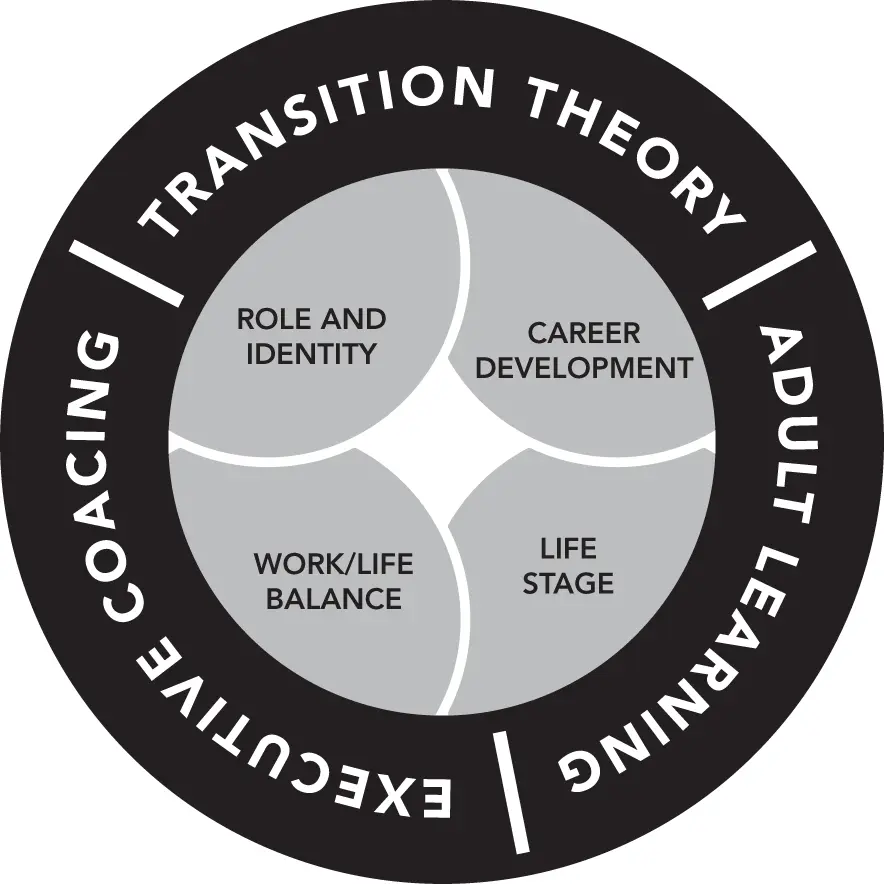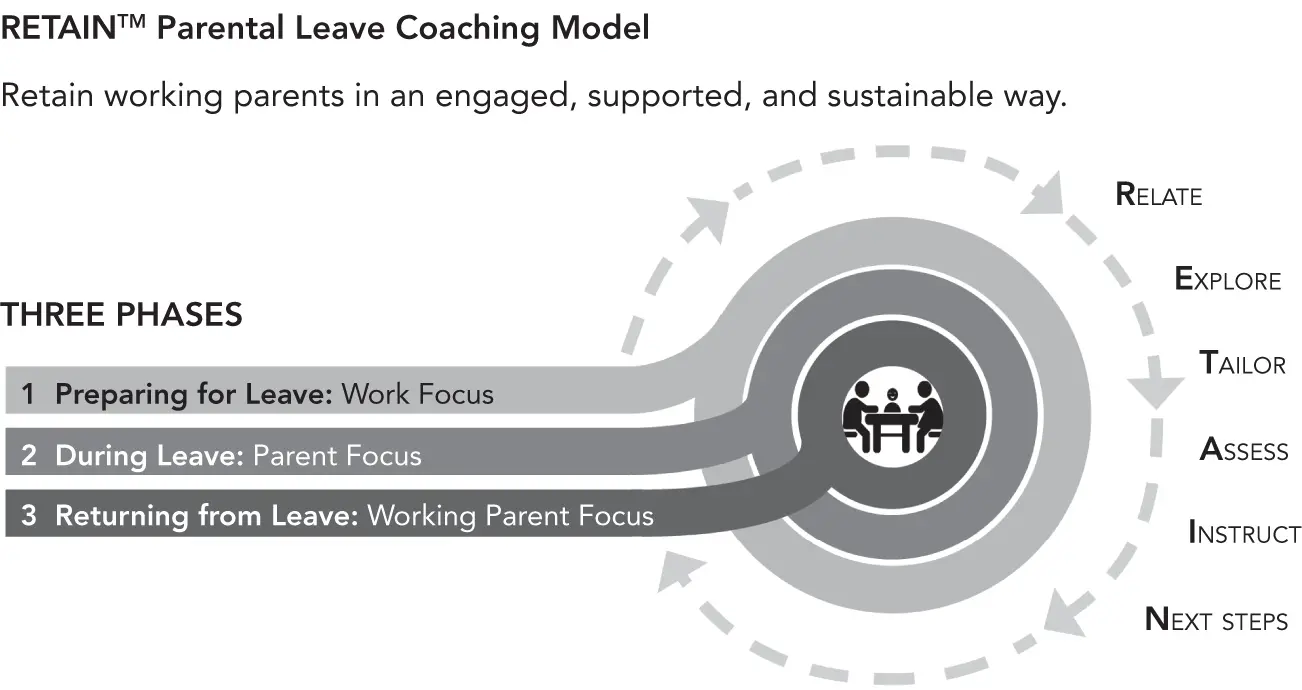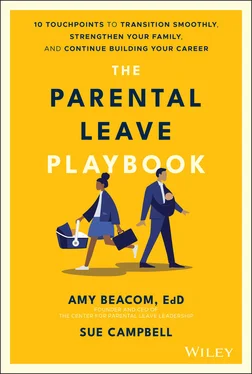
At its simplest, RETAIN is an acronym that stands for Relate, Explore, Tailor, Assess, Instruct , and Next Steps . This iterative process our parental leave coaches cycle through as they work provides a way for you to orient yourself along your journey.
Relate. Building trusting relationships in all areas of your life is one of the most important things you can do to ensure your successful transition. The R is first on purpose.
Explore. Deliberate exploration, with a curious mindset, of goals, desires, needs, and limitations—your own and those of the people around you—will help you uncover strengths and opportunities you may not have known you had and imagine solutions for any issues you find.
Tailor. You are an individual at a specific moment in time, with specific needs. Your next parental leave transition, if there is one, will be different because you will be different. The T reminds us that customization enables the transition to be effective and enjoyable and to meet the needs of your situation.
Assess. Taking stock of everything going on within you and around you by thoroughly assessing and reflecting on your transition will help ensure all your needs can be met by whatever plans you create (and you'll learn about yourself in the process).
Instruct. In a departure from traditional coaching, RETAIN coaches do a fair bit of overt teaching to clients. We recognize that sometimes when a person is learning an enormous amount of information in a very short time, it can really help to lay out the best practices and offer tips. This book and any further self-study you choose are that instruction.
Next Steps: Action Plan. All the previous elements fall flat if you do not pay attention to this last step and intentionally build what you have learned into a comprehensive plan to lead your leave. We call this plan your Next Steps: Action Plan, and there are three components of your plan: preparing for leave, during leave, and returning from leave.

RETAIN Parental Leave Transition Coaching is a structured and holistic form of coaching developed to support working parents and their managers from a business and personal perspective throughout the three phases of leave with an overt goal of ensuring a successful, engaged, and sustainable return to work while thriving at home.
It's easy to read the word RETAIN and think it is only about employee retention. However, RETAIN is not simply about staying in your job, though one of my overt aims is to keep parents—especially women—in the workforce if that is where they want to be. This type of coaching puts you, the working parent, at the center while also considering the needs of your work organization. At its core, RETAIN is about staying in all parts of your life, about sticking to the career course you choose while also staying consciously aligned with your higher self and deeper knowing—which may mean some pivots and unexpected turns. Ultimately, tapping into that part of yourself is key to long-term retention in whatever you choose to pursue.
As you navigate your parental leave with the help of this book, remember that this deep RETAIN foundation is already built into the 10-touchpoint framework you are about to learn, so you don't have to think about it. It can be comforting, though, to know it is there.

The Three-Phase Parental Leave Transition
The 10-touchpoint framework of this playbook is built on the idea that the parental leave transition breaks down into three phases—each equal in importance. Don't think of this time as an absence as the word leave implies, but rather as a period of personal and professional presence in transition, defined by the three phases shown in the figure.
A supported transition, such as the one you imagined at the beginning of the last chapter, can help your family flourish. When your family thrives, you can bring your best self back to the workforce and help your work organization and your community thrive as well.
Each phase has its own focus, its own set of touchpoints, and its own set of role changes. When you understand how to handle these touchpoints and role shifts well, you significantly improve your chances of transition success—again, however you define success. First, let's look at the three phases of the 10-touchpoint framework. Then we'll discuss roles, identities, and routines.
Phase 1: Preparing for Leave: Work Focus
In the first transition phase of the framework, you are still working and focused on career stability while you make preparations—both at work and at home—to welcome your new child. You are starting to feel the shift in your roles already, and you are working to figure out how this new parenting role will fit into the current picture of your life. Practically speaking, at home you are preparing for your child’s arrival. You may be rearranging your space or even moving to a larger home or to be closer to family. At work, you are trying to wrap up projects and create documentation for a clean handoff to whoever is covering your duties during your leave. You are also considering how to do everything in a way that makes your manager and team happy. If you have any extra headspace, you might be using it to think about setting yourself up for a smooth return.
The first mile marker or touchpoint we will go into for this phase is your announcementat work that you are expecting a child. This sounds simple enough, but in many workplace cultures an announcement can be tricky and expectant parents are often surprised by the way other people react. Even if you have already made your announcement by the time you are reading this book, we will explore ways you can look at the impact your announcement had and be creative about positive ways to talk about the arrival of your child going forward.
The second touchpoint of Phase 1 is about how to assessyour transition. I'll show you how to look at your transition from some specific angles using a tool we call the 6-S System for Transition Success . This process will help you identify everything working in your favor as well as anything working against you, in order to actively make the most of resources you have available to you and plan for mitigating challenging circumstances.
The third touchpoint has to do with leave planning and communication. I will walk you through how to create a comprehensive three-phase leave action planthat includes how best to get all of your stakeholders the information they need. You will use what you've discovered in your transition assessment from the second touchpoint to create a plan (and a backup plan or two!) for work and home purposes.
The fourth and final touchpoint of Phase 1 is to acknowledge the transition to parenthood . This section will help you understand why it is important to make time in your hectic schedule to soak in the enormity of the life transition you are embarking on so you can prepare emotionally and find ways to celebrate that feel right to you. Busy as you are, it's tempting to skip this part, but that never ends well. On a practical level, it pays to spend time thinking about the kind of parent you want to be and what your new life will look like so you can build it into your plans and goal setting. On an emotional level, giving yourself the room to truly acknowledge and embrace the magnitude of your new life path will help you develop and practice the self-awareness and emotional intelligence required of all working parents (and leaders).
Читать дальше















